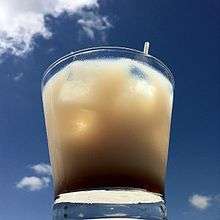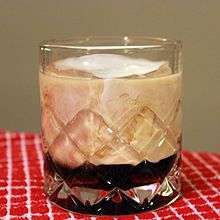White Russian (cocktail)
| Cocktail | |
|---|---|
 A mixed White Russian cocktail | |
| Type | Cocktail |
| Primary alcohol by volume | |
| Served | On the rocks; poured over ice |
| Standard drinkware |
 |
| Commonly used ingredients |
|
| Preparation | Pour coffee liqueur and vodka into an Old Fashioned glass filled with ice. Float fresh cream on top and stir slowly. |

A White Russian is a cocktail made with vodka, coffee liqueur (e.g., Kahlúa or Tia Maria), and cream served with ice in an Old Fashioned glass. Often milk will be used as an alternative to cream.
History
The traditional cocktail known as a Black Russian, which first appeared in 1949, becomes a White Russian with the addition of cream. Neither drink is Russian in origin, but both are so named due to vodka being the primary ingredient. It is unclear which drink preceded the other.[1][2]
The Oxford English Dictionary[3] refers to the first mention of the word "White Russian" in the sense of a cocktail as appearing in California's Oakland Tribune on November 21, 1965.[4] It was placed in the newspaper as an insert: "White Russian. 1 oz. each Southern, vodka, cream",[5] with "Southern" referring to Coffee Southern, a short-lived brand of coffee liqueur by Southern Comfort.[6]
Though long regarded as a boring and unsophisticated drink, the White Russian saw a surge in popularity after the 1998 release of the film The Big Lebowski, throughout which it appears as the protagonist's beverage of choice.[7] Literary critic Craig Owens has examined the drink's role in the film, observing that its name and casual preparation reflect the protagonist's New Left politics and castrated masculinity.[8][9]
Preparation
As with all cocktails, various modes of preparation exist, varying according to the recipes and styles of particular bars or mixologists. Most common varieties have adjusted amounts of vodka or coffee liqueur, or mixed brands of coffee liqueur. Shaking the cream in order to thicken it prior to pouring it over the drink is also common. Sometimes the drink is prepared on the stove with hot coffee for a warm treat on cold days.
Variations
Many variants of the cocktail exist, both localised and widely known, such as a Blind Russian (which substitutes the cream with Baileys Irish Cream), a Mudslide (a Blind Russian with added cream), White Canadian (made with goat's milk), an Anna Kournikova (named after the tennis player, made with skimmed milk, i.e. a "skinny, low-fat" White Russian), a White Cuban (made with rum instead of vodka), or a Dirty Russian (made with chocolate milk instead of cream).[10][11]
See also
References
- ↑ Sicard, Cheri (August 6, 2007). "Featured Cocktails – Black Russian and White Russian". FabulousFoods.com. Retrieved June 8, 2010.
- ↑ "10 Famous Cocktails and Where They Were Born". bootsnall.com. Retrieved February 9, 2017.
- ↑ "June 2007 Update : Oxford English Dictionary". oed.com. Retrieved February 9, 2017.
- ↑ "The History of the White Russian". nicoledigiose.com. August 10, 2012. Retrieved February 9, 2017.
- ↑ "White Russian, n. and a.". Oxford English Dictionary. June 2007. Retrieved May 6, 2010.
- ↑ "An Enthusiast's Guide to Cocktails: the White Russian". The Alcohol Enthusiast. May 11, 2011. Retrieved December 2, 2011.
- ↑ Kurutz, Steven (2 December 2008). "White Russians Arise, This Time at a Bowling Alley". The New York Times. Retrieved 9 January 2014.
- ↑ Owens, Craig N. (2009). "On the White Russian". In Comentale, Edward P.; Jaffe, Aaron. The Year's Work in Lebowski Studies.
- ↑ Garner, Dwight (29 December 2009). "Dissertations on His Dudeness". The New York Times. Retrieved 12 August 2017.
- ↑ "The Snows of Revolution". The Boise Weekly. 2006. Retrieved December 31, 2010.
- ↑ "White Russian". Conan's Pub. 2006. Retrieved May 6, 2010.
Further reading
| Wikimedia Commons has media related to White Russian (cocktail). |
- Steven Kurutz (December 2, 2008). "White Russians Arise, This Time at a Bowling Alley". The New York Times. Retrieved July 15, 2011.
- The Dudely Lama (June 14, 2009). "The White Russian Revolution". The Dudespaper. Retrieved July 16, 2012.
